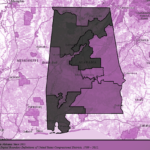This is the eighth article of a 10 part series on redistricting + apportionment + gerrymandering, in relation to Alabama.
As discussed in part seven, even though the judgment of LWVUS is that our option in Alabama is federal, aren’t there other things we can do? We know that the Permanent Legislative Committee on Reapportionment is tasked with drawing the new maps on the basis of the Census data. Its guidelines below indicate that any individual citizen or organization may submit redistricting plans to the committee which become part of the public record. Such maps can provide comparisons with those that the committee produces. This is uncharted territory with access of regular citizens to such technology, so we can’t predict how such things will play out.
Some Alabama League members are being trained in one mapping software, Maptitude, for which LWVUS has purchased a license.
Dave’s Redistricting App is a free and user-friendly software mapping tool for personal use that can be used by individuals to draw their own maps.
DistrictR is another.
The current League standards on which a redistricting plan is based, and on which any plan should be judged, must:
- Be enforceable in court;
- Require:
- Substantially equal population,
- Geographic contiguity, and
- Effective representation of racial and linguistic minorities.
- Provide for (to the extent possible):
- Promotion of partisan fairness,
- Preservation and protection of “communities of interest,” and
- Respect for boundaries of municipalities and counties.
- Compactness and competitiveness may also be considered as criteria so long as they do not conflict with the above criteria
- Explicitly reject:
- Protection of incumbents, through such devices as considering an incumbent’s
- address; and
- Preferential treatment for a political party, through such devices as considering party affiliation, voting history and candidate residence.
According to the Alabama Reapportionment Committee Redistricting Guidelines, as of May 5, 2021, the first two paragraphs under “public access” are:
- The Reapportionment Committee seeks active and informed public participation in all activities of the Committee and the widest range of public information and citizen input into its deliberations. Public access to the Reapportionment Office computer system is available every Friday from 8:30 a.m. to 4:30 p.m. Please contact the Reapportionment Office to schedule an appointment. (see link below to AL Legislature website for committee)
- A redistricting plan may be presented to the Reapportionment Committee by any individual citizen or organization by written presentation at a public meeting or by submission in writing to the Committee. All plans submitted to the Reapportionment Committee will be made part of the public record and made available in the same manner as other public records of the Committee.
Read the entire set of Redistricting Guidelines here. It will be important for us to scrutinize these guidelines and track their application, to determine the extent to which they allow gerrymandering or deter it.
You can go directly to the Committee webpage on the Alabama Legislature website.
There are useful links to membership (although it seems that members are not identified by political party on the list), to a history of the process in Alabama in the 20th and 21st centuries, to documents related to the history, to redistricting maps, and under “Meetings and Announcements” you can find the guidelines for redistricting, mentioned above. The schedule has not yet been set, but according to an al.com article from July 15, the committee expects to hold about 28 public hearings around the state. You can view the schedule on the Committee website under “Meetings and Notices.”
The best course of action for private citizens and representatives of community groups is to attend a public hearing and present testimony on how district lines would affect them and their community. See part 10 for discussion of state-level redistricting, in contrast with Congressional-level redistricting.
We will have links to helpful guides to preparing written testimony for submission to a committee, and to speaking from that testimony before a committee.
This series is a joint effort of the blog editor, Catherine Davies, and other members of the Advocacy Team and Board of the League of Women Voters of Alabama.

